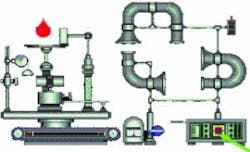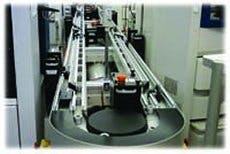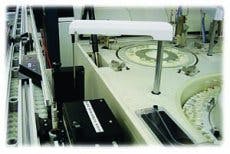Large total laboratory automation systems soon reached market saturation, and many questions were being raised as to whether these customized systems were truly providing the purported ROI. As a result, vendors began to address the needs of intermediate-size facilities with modular or task-targeted automation
(TTA).
These systems can be divided into two types. First, there are homologous test systems, in which identical analyzers are piggybacked onto each other to increase throughput and menu capacity. Examples include the Olympus AU5400, (Olympus America, Melville, NY), which combines two AU2700 modules for a larger throughput system; Roche Diagnostics (Basel, Switzerland) Modular Analytics, which offers several configurations of piggybacked chemistry modules; and Abbott Laboratories (Abbott Park, IL) Architect Series, which could combine two chemiluminescent immunoassay analyzers into a larger system.
Newer to the market are heterologous TTA systems in which a conventional chemistry analyzer is linked to a chemiluminescent immunoassay analyzer that provide an even greater expansion of test menu and create greater opportunities for test consolidation and expansion of services.
Similar heterologous systems for serum/plasma testing have been slower in their release. Heterologous TTA systems for chemistry/immunoassay previously required some type of semicustomized automation to integrate diverse testing platforms, often from different vendors. These systems were still relatively expensive, and frequently required a leap of faith that they would provide a ROI. Vendors often agreed to assume some of the risk, but hospital administrators are often reluctant to sign agreements where the final costs are to be determined.
Lacking in these open design philosophy systems were both software and hardware interfaces to the analytic instruments. Software and hardware interfaces can always theoretically be implemented, but at what price? Some early adopters had erected extensive track systems, which took the tube on a tour of the laboratory to reach one or two analyzers. When an analyzer was upgraded, that meant upgrading the interfaces, which could be a costly proposition if it had not been done before. The problem was and remains that standardization of interface design from a hardware-and-software viewpoint is still lacking.
A one-vendor solution has much appeal, if the vendor can truly provide heterologous integration at a lower cost, thereby making a financial ROI more attainable. Dade Dimension (Dade Behring, Deerfield, IL), with its heterologous module, was one of the first analyzers to attempt integration of both immunoassay testing and routine chemistry testing. Most hospital laboratories, however, still found it necessary to add other platforms to complete the test menu and/or maintain their test throughput and capacity. Within the last 12 to 18 months, almost all of the major vendors have been rolling out a new breed of TTA analyzer systems the integrated chemistry-immunoassay modular system. This integrated system promises to consolidate a large volume of the laboratory test menu into one system that can perform the testing on one tube, greatly simplifying the overall process.
Based on our test volume and pre-installation workflow analysis, our system included two Advia 1650s and two Advia Centaurs linked with an 18-foot circulating track and a specimen sorter/archiver, the Advia Sample Manager (Figure 2). Centrifugation and decapping were performed off the system at the time the specimen was receipted into the laboratory.
Integrated heterologous systems offer an antidote to extensive front-end processing. An examination of a typical laboratorys front-end workflow often reveals complexity because of the still-existent diverse analytical platforms. Each platform requires its own aliquot or tube to complete testing in a timely fashion. This means more centrifugation, more decapping, more aliquoting and labeling, more sorting, and more waste. Additionally, most hospitals do not staff to run all platforms 24 hours per day. For example, specimens for immunoassay testing are often held over until the next day, which means additional sorting and the daily tube hunt to set up the days run. The delays in turnaround time caused by front-end specimen handling in a traditional workflow impacts the entire laboratory testing process.
Stand-alone front-end processing vs.
integrated chemistry/immunoassay
Our decision to concentrate on integrating chemistry and immunoassay, rather than implementing a front-end TTA stand-alone module, was predicated on the above concept. Front-end automation does not eliminate the above problems; it just automates them. Our pre-installation workflow analysis suggested that at peak times a front-end automation system would adversely affect turnaround time, and we would, therefore, have to implement an alternative pathway for stat or urgent specimens. Also, stand-alone front-end automation did little to streamline the analytical process. If heterologous systems could complete 95 percent of our serum or plasma testing in a timely fashion, though, that would eliminate the need for a separate stat testing pathway and reduce the need for front-end automation. The improvement in the process could be dramatic.
Our experience with a heterologous TTA system has been overwhelmingly positive. The system has had a major impact on all phases of the lab testing process. Reduction of serum tubes, in turn, decreases the labor associated with front-end processing. Prior to implementation of the Advia WorkCell, we were processing an average of 1,377 serum tubes per day. Following implementation, we were able to immediately reduce the number of tubes we were handling by 37 percent. Near total elimination of aliquoting has also been achieved, as specimen sorting for additional testing has become a back-end process after completion of the majority of testing. On average, tubes are returned to the specimen sorter within 6.5 minutes. A unique feature of the Advia WorkCell is that specimen sorting can be done on the WorkCell in an automated fashion post-processing without human handling. The impact on turnaround time is obvious. The tubes are automatically sorted for testing to be done on other analyzers or for send-out testing. The process of specimen handling has been greatly simplified, with specimens going from receipt to centrifuge to decapping to analyzer without front-end aliquoting or sorting. We have seen a reduction of routine median turnaround time from one hour and 41 minutes to a median of 52 minutes for both chemistry and immunoassay testing. This was based on receipt to result.
We were able to realize economic advantages with an integrated TTA system. FTE reduction was achieved through attrition. We experienced a significant improvement in our billable test per FTE
(Figure 3). This has resulted in an overall reduction in our cost per billable and an improvement of 20 percentile points in our interhospital benchmark scores.
A major additional benefit was the expansion of our test menu with 24-hour availability of what before was considered esoteric testing. With an integrated chemistry/immunoanalyzer system, nothing is held over for the day shift. If a clinician requests thyroid hormones or tumor markers at 3 a.m., the testing is completed then. The consolidation of testing onto one tube thereby greatly simplified the entire process, resulting in improvements in costs, complexity, turnaround time, error reduction and safety to our technologists.
References
1. Smythe, MH, Automation: Triumph or Trap? Clinical Lab Management Review. 1997;11:360-364.
2. Demiris CH, Clement PR: Task targeted automation TTA from Roche Diagnostics provide a cost-effective and easily justified approach to automation for improving the efficiency of the clinical laboratory. J Assoc Lab Automation. 1998;3:64-67.
Herbert E. Auerbach, DO, is Chairman, Department of Pathology, and Kathryn Durr is Administrative Director, Abington Memorial Hospital, Abington, PA.
May 2003: Vol. 35, No. 5
© 2003 Nelson Publishing, Inc. All rights reserved.




